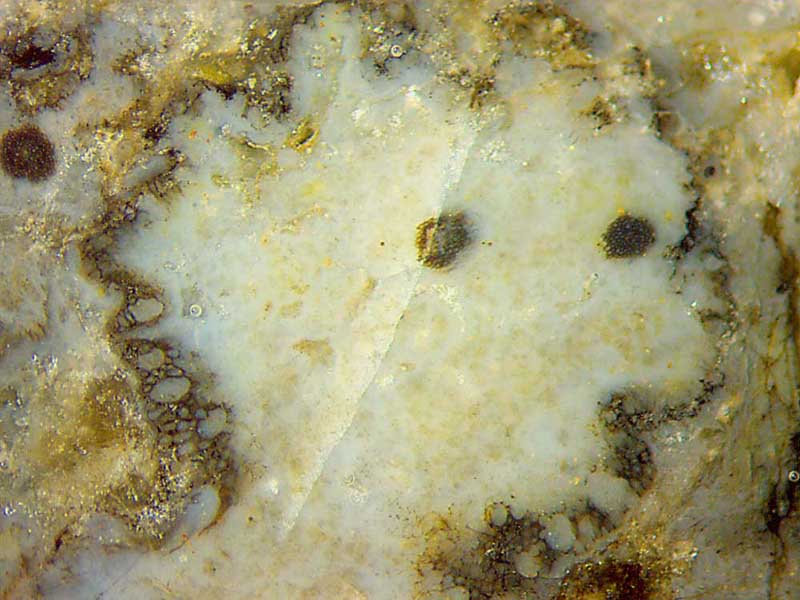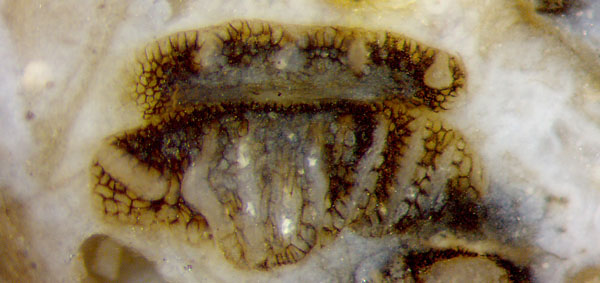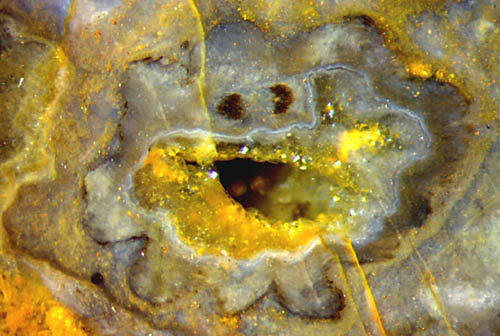 Scary
Nothia
Scary
Nothia
To
those who are acquainted with the Rhynie chert fossils, this headline
must seem inappropriate. Every time when a friendly or
curiously looking "face" is seen on surfaces or cut faces of Rhynie
chert, it is most often a section of the small plant Nothia
(Fig.1). One would not have thought that this early land plant had
already developed an elaborate technique for scaring
off unwelcome guests.
Fig1: Nothia,
part of a cross-section
of a forking shoot near the point of separation, with sections of big
tubes. Width of the picture 4.3mm.
This small Lower Devonian plant is remarkable for
a unique feature: big
tubes running below the surface, with volumes equalling that of
hundreds
of normal cells taken together, first discussed in [1] and
tentatively re-interpreted
later on the basis of own finds [2]. They are
seen here more clearly than usual.
They are thought to be filled
with some deterrent liquid which spills out when the vessel is tapped,
thus repelling small
herbivorous creatures trying to suck sap or to get
at the spores.
While the shoot in Fig.1 had
not yet separated, the central strand had forked twice, with two
sections seen here. The big tubes are seen clustering,
for whichever reason, at some places at the periphery. Possibly they
are about to extend
into the capsule stalks and into the capsule walls, where they may
cause the imaginative observer to see a scary monster confronting him
with 4 eyes which really are tube sections (Fig.2).
In order to
understand what is seen in Fig.2, one should try to imagine the
3D-shape of a kind of broad mouth
extending half arond
the capsule. Fig.2 may seem confusing
because the sample had been cut incidentally such
that the
upper "lip" or valve is seen in cross-section but the lower one is seen
nearly
parallel to the
cut, owing to its deviating orientation. Hence, the big tubes are seen
in cross-section above and in
roughly longitudinal section below.
The
valves are supposed to separate at maturity so that the spores are
released through the resulting gap. In view of the peculiar features, Nothia can be
considered a rather advanced early land plant.

Fig.2 (right): Nothia
sporangium, rare
sight with cut face of the sample (picture plane) nearly parallel to
the
"mouth" front. Width of the picture 2mm.
The idea of the tubes being vessels for deterrent liquid is
suggested by three observations:
- There are no tubes on the lower parts of the plant [1].
- The tubes seem to have formed by the lesion of the walls of
lots of cells
at or near the surface [2].
- Lesion of cell walls to make tubes for deterrent
liquid is known from
flowering plants.
The tubes are usually positioned such that only a narrow strip along
the epidermis is seen, as in Rhynie
Chert News 57.
There, Figs.6,7 indicate
the presence of a big tube behind the surface. This is compatible with
the tube
cross-section in Fig.2, above right. Other tube cross-sections are less
distinctly seen here and elsewhere. Some tubes with elliptical
cross-section in Fig.1 seem to be positioned below the epidermis.

It
is hoped that more details will appear on other Rhynie chert samples
which might either support or doubt the poison tube idea.
Unfortunately, most sections are of not much use in this connection,
like the really scary one on the left.
Fig.3: Nothia
cross-section, hollow before silicification, cavity
partially filled with crystalline quartz.
Width of the picture 3.5mm.
H.-J.
Weiss
2017
[1] H.
Kerp, H.
Hass, V. Mosbrugger: New data
on Nothia aphylla,
in:
P.G. Gensel,
D. Edwards (eds.): Plants Invade the Land, N.Y. 2001
[2] Rhynie Chert News 33.
 |
 |
110 |
 Scary
Nothia
Scary
Nothia
 Scary
Nothia
Scary
Nothia



